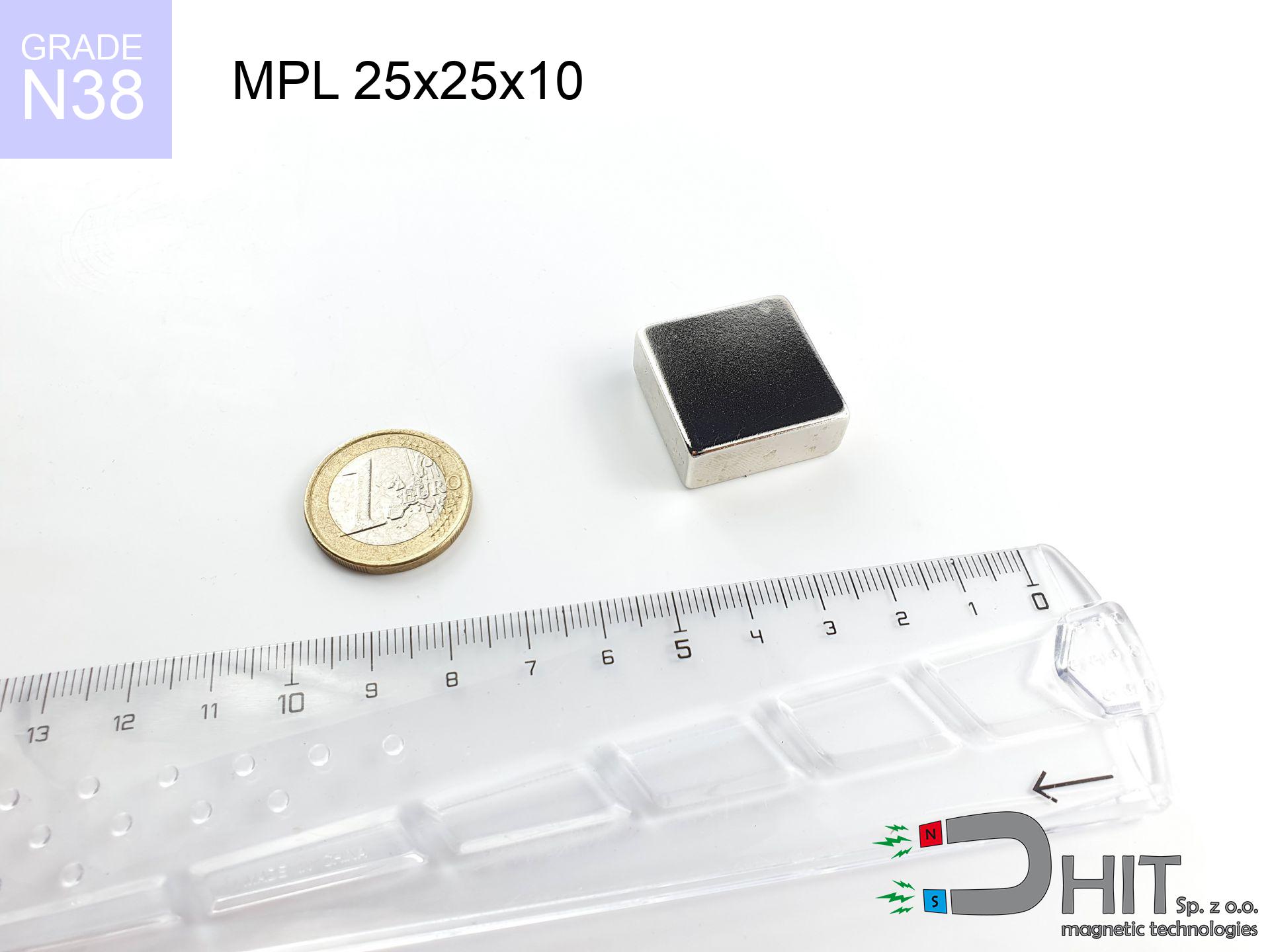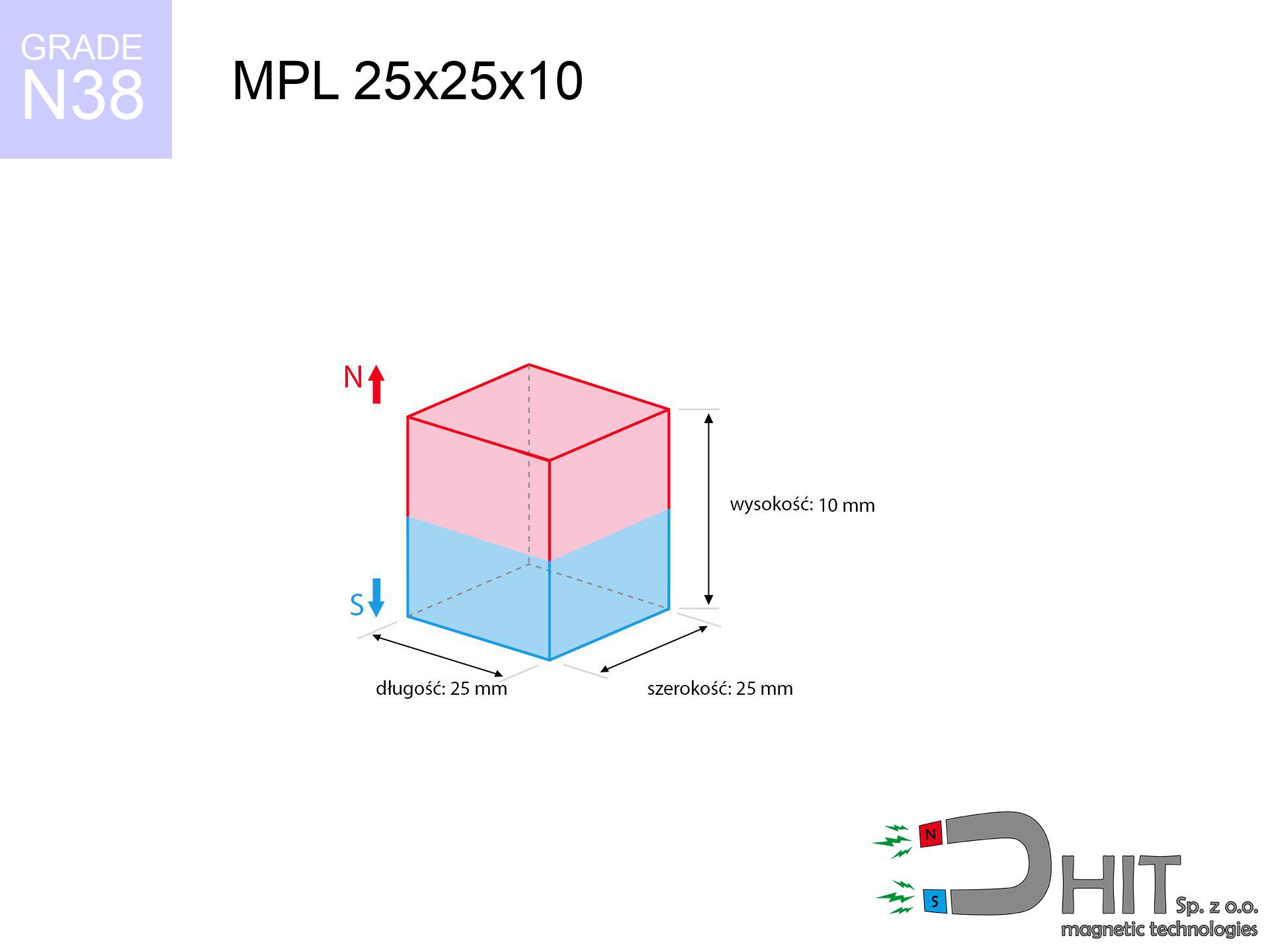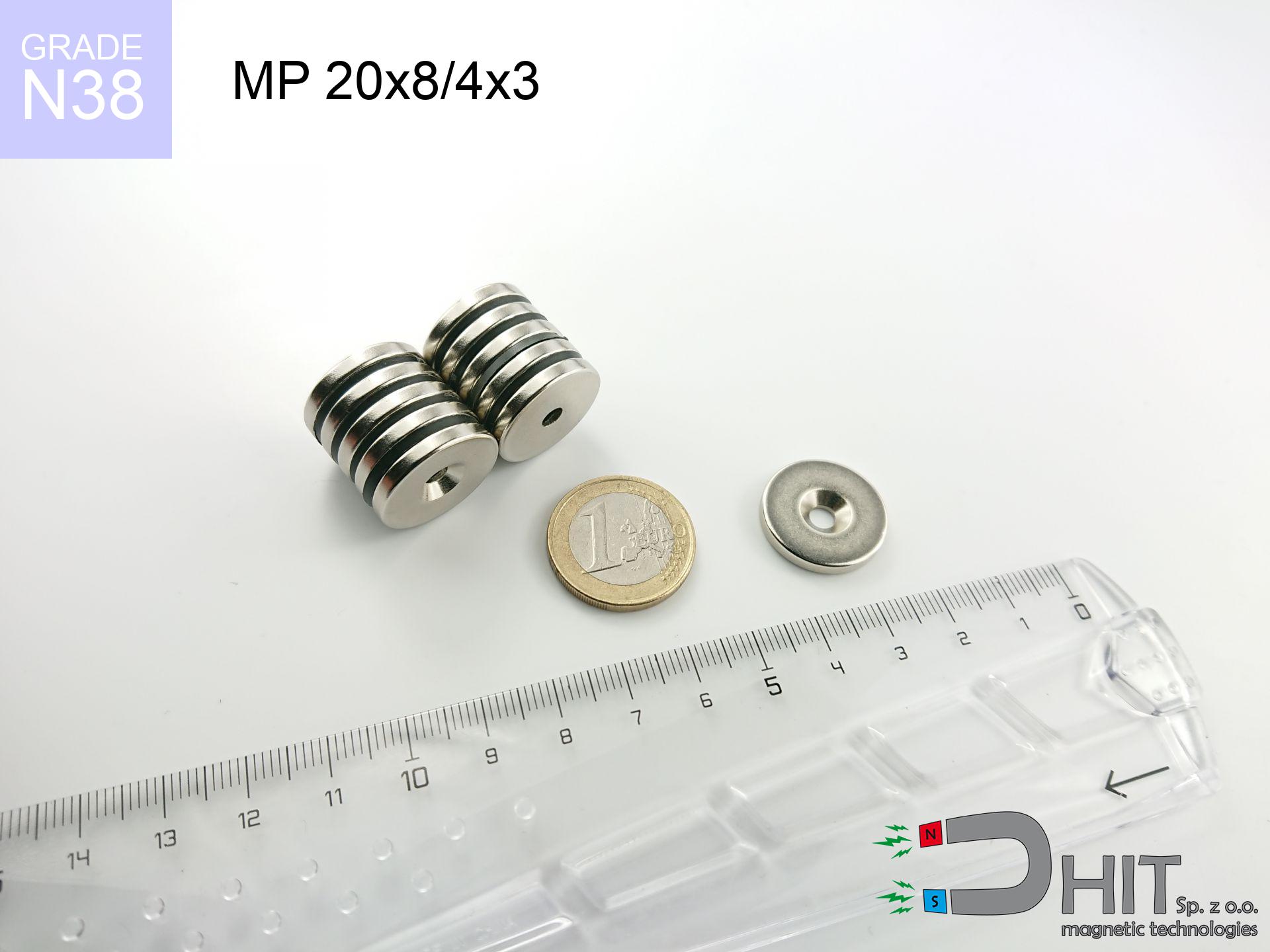MPL 25x25x10 / N38 - lamellar magnet
lamellar magnet
Catalog no 020137
GTIN/EAN: 5906301811435
length
25 mm [±0,1 mm]
Width
25 mm [±0,1 mm]
Height
10 mm [±0,1 mm]
Weight
46.88 g
Magnetization Direction
↑ axial
Load capacity
19.39 kg / 190.25 N
Magnetic Induction
361.04 mT / 3610 Gs
Coating
[NiCuNi] Nickel
20.29 ZŁ with VAT / pcs + price for transport
16.50 ZŁ net + 23% VAT / pcs
bulk discounts:
Need more?
Give us a call
+48 22 499 98 98
otherwise let us know through
contact form
the contact form page.
Weight along with structure of a magnet can be analyzed on our
online calculation tool.
Orders submitted before 14:00 will be dispatched today!
Technical data - MPL 25x25x10 / N38 - lamellar magnet
Specification / characteristics - MPL 25x25x10 / N38 - lamellar magnet
| properties | values |
|---|---|
| Cat. no. | 020137 |
| GTIN/EAN | 5906301811435 |
| Production/Distribution | Dhit sp. z o.o. |
| Country of origin | Poland / China / Germany |
| Customs code | 85059029 |
| length | 25 mm [±0,1 mm] |
| Width | 25 mm [±0,1 mm] |
| Height | 10 mm [±0,1 mm] |
| Weight | 46.88 g |
| Magnetization Direction | ↑ axial |
| Load capacity ~ ? | 19.39 kg / 190.25 N |
| Magnetic Induction ~ ? | 361.04 mT / 3610 Gs |
| Coating | [NiCuNi] Nickel |
| Manufacturing Tolerance | ±0.1 mm |
Magnetic properties of material N38
| properties | values | units |
|---|---|---|
| remenance Br [min. - max.] ? | 12.2-12.6 | kGs |
| remenance Br [min. - max.] ? | 1220-1260 | mT |
| coercivity bHc ? | 10.8-11.5 | kOe |
| coercivity bHc ? | 860-915 | kA/m |
| actual internal force iHc | ≥ 12 | kOe |
| actual internal force iHc | ≥ 955 | kA/m |
| energy density [min. - max.] ? | 36-38 | BH max MGOe |
| energy density [min. - max.] ? | 287-303 | BH max KJ/m |
| max. temperature ? | ≤ 80 | °C |
Physical properties of sintered neodymium magnets Nd2Fe14B at 20°C
| properties | values | units |
|---|---|---|
| Vickers hardness | ≥550 | Hv |
| Density | ≥7.4 | g/cm3 |
| Curie Temperature TC | 312 - 380 | °C |
| Curie Temperature TF | 593 - 716 | °F |
| Specific resistance | 150 | μΩ⋅cm |
| Bending strength | 250 | MPa |
| Compressive strength | 1000~1100 | MPa |
| Thermal expansion parallel (∥) to orientation (M) | (3-4) x 10-6 | °C-1 |
| Thermal expansion perpendicular (⊥) to orientation (M) | -(1-3) x 10-6 | °C-1 |
| Young's modulus | 1.7 x 104 | kg/mm² |
Engineering modeling of the magnet - report
The following values constitute the direct effect of a engineering simulation. Results were calculated on algorithms for the class Nd2Fe14B. Actual conditions might slightly differ. Treat these calculations as a preliminary roadmap when designing systems.
Table 1: Static force (pull vs distance) - characteristics
MPL 25x25x10 / N38
| Distance (mm) | Induction (Gauss) / mT | Pull Force (kg/lbs/g/N) | Risk Status |
|---|---|---|---|
| 0 mm |
3610 Gs
361.0 mT
|
19.39 kg / 42.75 LBS
19390.0 g / 190.2 N
|
dangerous! |
| 1 mm |
3392 Gs
339.2 mT
|
17.12 kg / 37.74 LBS
17117.7 g / 167.9 N
|
dangerous! |
| 2 mm |
3156 Gs
315.6 mT
|
14.82 kg / 32.68 LBS
14822.5 g / 145.4 N
|
dangerous! |
| 3 mm |
2913 Gs
291.3 mT
|
12.63 kg / 27.85 LBS
12631.8 g / 123.9 N
|
dangerous! |
| 5 mm |
2436 Gs
243.6 mT
|
8.83 kg / 19.46 LBS
8827.9 g / 86.6 N
|
strong |
| 10 mm |
1464 Gs
146.4 mT
|
3.19 kg / 7.04 LBS
3191.5 g / 31.3 N
|
strong |
| 15 mm |
872 Gs
87.2 mT
|
1.13 kg / 2.49 LBS
1131.5 g / 11.1 N
|
safe |
| 20 mm |
538 Gs
53.8 mT
|
0.43 kg / 0.95 LBS
430.4 g / 4.2 N
|
safe |
| 30 mm |
234 Gs
23.4 mT
|
0.08 kg / 0.18 LBS
81.8 g / 0.8 N
|
safe |
| 50 mm |
68 Gs
6.8 mT
|
0.01 kg / 0.02 LBS
6.9 g / 0.1 N
|
safe |
Table 2: Slippage capacity (vertical surface)
MPL 25x25x10 / N38
| Distance (mm) | Friction coefficient | Pull Force (kg/lbs/g/N) |
|---|---|---|
| 0 mm | Stal (~0.2) |
3.88 kg / 8.55 LBS
3878.0 g / 38.0 N
|
| 1 mm | Stal (~0.2) |
3.42 kg / 7.55 LBS
3424.0 g / 33.6 N
|
| 2 mm | Stal (~0.2) |
2.96 kg / 6.53 LBS
2964.0 g / 29.1 N
|
| 3 mm | Stal (~0.2) |
2.53 kg / 5.57 LBS
2526.0 g / 24.8 N
|
| 5 mm | Stal (~0.2) |
1.77 kg / 3.89 LBS
1766.0 g / 17.3 N
|
| 10 mm | Stal (~0.2) |
0.64 kg / 1.41 LBS
638.0 g / 6.3 N
|
| 15 mm | Stal (~0.2) |
0.23 kg / 0.50 LBS
226.0 g / 2.2 N
|
| 20 mm | Stal (~0.2) |
0.09 kg / 0.19 LBS
86.0 g / 0.8 N
|
| 30 mm | Stal (~0.2) |
0.02 kg / 0.04 LBS
16.0 g / 0.2 N
|
| 50 mm | Stal (~0.2) |
0.00 kg / 0.00 LBS
2.0 g / 0.0 N
|
Table 3: Vertical assembly (shearing) - behavior on slippery surfaces
MPL 25x25x10 / N38
| Surface type | Friction coefficient / % Mocy | Max load (kg/lbs/g/N) |
|---|---|---|
| Raw steel |
µ = 0.3
30% Nominalnej Siły
|
5.82 kg / 12.82 LBS
5817.0 g / 57.1 N
|
| Painted steel (standard) |
µ = 0.2
20% Nominalnej Siły
|
3.88 kg / 8.55 LBS
3878.0 g / 38.0 N
|
| Oily/slippery steel |
µ = 0.1
10% Nominalnej Siły
|
1.94 kg / 4.27 LBS
1939.0 g / 19.0 N
|
| Magnet with anti-slip rubber |
µ = 0.5
50% Nominalnej Siły
|
9.70 kg / 21.37 LBS
9695.0 g / 95.1 N
|
Table 4: Material efficiency (substrate influence) - power losses
MPL 25x25x10 / N38
| Steel thickness (mm) | % power | Real pull force (kg/lbs/g/N) |
|---|---|---|
| 0.5 mm |
|
0.97 kg / 2.14 LBS
969.5 g / 9.5 N
|
| 1 mm |
|
2.42 kg / 5.34 LBS
2423.8 g / 23.8 N
|
| 2 mm |
|
4.85 kg / 10.69 LBS
4847.5 g / 47.6 N
|
| 3 mm |
|
7.27 kg / 16.03 LBS
7271.3 g / 71.3 N
|
| 5 mm |
|
12.12 kg / 26.72 LBS
12118.8 g / 118.9 N
|
| 10 mm |
|
19.39 kg / 42.75 LBS
19390.0 g / 190.2 N
|
| 11 mm |
|
19.39 kg / 42.75 LBS
19390.0 g / 190.2 N
|
| 12 mm |
|
19.39 kg / 42.75 LBS
19390.0 g / 190.2 N
|
Table 5: Thermal stability (material behavior) - resistance threshold
MPL 25x25x10 / N38
| Ambient temp. (°C) | Power loss | Remaining pull (kg/lbs/g/N) | Status |
|---|---|---|---|
| 20 °C | 0.0% |
19.39 kg / 42.75 LBS
19390.0 g / 190.2 N
|
OK |
| 40 °C | -2.2% |
18.96 kg / 41.81 LBS
18963.4 g / 186.0 N
|
OK |
| 60 °C | -4.4% |
18.54 kg / 40.87 LBS
18536.8 g / 181.8 N
|
|
| 80 °C | -6.6% |
18.11 kg / 39.93 LBS
18110.3 g / 177.7 N
|
|
| 100 °C | -28.8% |
13.81 kg / 30.44 LBS
13805.7 g / 135.4 N
|
Table 6: Magnet-Magnet interaction (repulsion) - field range
MPL 25x25x10 / N38
| Gap (mm) | Attraction (kg/lbs) (N-S) | Sliding Force (kg/lbs/g/N) | Repulsion (kg/lbs) (N-N) |
|---|---|---|---|
| 0 mm |
50.20 kg / 110.68 LBS
5 073 Gs
|
7.53 kg / 16.60 LBS
7531 g / 73.9 N
|
N/A |
| 1 mm |
47.31 kg / 104.30 LBS
7 008 Gs
|
7.10 kg / 15.65 LBS
7097 g / 69.6 N
|
42.58 kg / 93.87 LBS
~0 Gs
|
| 2 mm |
44.32 kg / 97.71 LBS
6 783 Gs
|
6.65 kg / 14.66 LBS
6648 g / 65.2 N
|
39.89 kg / 87.94 LBS
~0 Gs
|
| 3 mm |
41.33 kg / 91.12 LBS
6 550 Gs
|
6.20 kg / 13.67 LBS
6200 g / 60.8 N
|
37.20 kg / 82.01 LBS
~0 Gs
|
| 5 mm |
35.49 kg / 78.25 LBS
6 070 Gs
|
5.32 kg / 11.74 LBS
5324 g / 52.2 N
|
31.94 kg / 70.43 LBS
~0 Gs
|
| 10 mm |
22.86 kg / 50.39 LBS
4 871 Gs
|
3.43 kg / 7.56 LBS
3429 g / 33.6 N
|
20.57 kg / 45.35 LBS
~0 Gs
|
| 20 mm |
8.26 kg / 18.22 LBS
2 929 Gs
|
1.24 kg / 2.73 LBS
1240 g / 12.2 N
|
7.44 kg / 16.40 LBS
~0 Gs
|
| 50 mm |
0.46 kg / 1.02 LBS
695 Gs
|
0.07 kg / 0.15 LBS
70 g / 0.7 N
|
0.42 kg / 0.92 LBS
~0 Gs
|
| 60 mm |
0.21 kg / 0.47 LBS
469 Gs
|
0.03 kg / 0.07 LBS
32 g / 0.3 N
|
0.19 kg / 0.42 LBS
~0 Gs
|
| 70 mm |
0.10 kg / 0.23 LBS
329 Gs
|
0.02 kg / 0.03 LBS
16 g / 0.2 N
|
0.09 kg / 0.21 LBS
~0 Gs
|
| 80 mm |
0.05 kg / 0.12 LBS
239 Gs
|
0.01 kg / 0.02 LBS
8 g / 0.1 N
|
0.05 kg / 0.11 LBS
~0 Gs
|
| 90 mm |
0.03 kg / 0.07 LBS
178 Gs
|
0.00 kg / 0.01 LBS
5 g / 0.0 N
|
0.03 kg / 0.06 LBS
~0 Gs
|
| 100 mm |
0.02 kg / 0.04 LBS
136 Gs
|
0.00 kg / 0.01 LBS
3 g / 0.0 N
|
0.02 kg / 0.04 LBS
~0 Gs
|
Table 7: Protective zones (implants) - warnings
MPL 25x25x10 / N38
| Object / Device | Limit (Gauss) / mT | Safe distance |
|---|---|---|
| Pacemaker | 5 Gs (0.5 mT) | 13.0 cm |
| Hearing aid | 10 Gs (1.0 mT) | 10.5 cm |
| Mechanical watch | 20 Gs (2.0 mT) | 8.0 cm |
| Mobile device | 40 Gs (4.0 mT) | 6.5 cm |
| Remote | 50 Gs (5.0 mT) | 6.0 cm |
| Payment card | 400 Gs (40.0 mT) | 2.5 cm |
| HDD hard drive | 600 Gs (60.0 mT) | 2.0 cm |
Table 8: Impact energy (kinetic energy) - warning
MPL 25x25x10 / N38
| Start from (mm) | Speed (km/h) | Energy (J) | Predicted outcome |
|---|---|---|---|
| 10 mm |
22.52 km/h
(6.26 m/s)
|
0.92 J | |
| 30 mm |
35.62 km/h
(9.89 m/s)
|
2.29 J | |
| 50 mm |
45.87 km/h
(12.74 m/s)
|
3.81 J | |
| 100 mm |
64.86 km/h
(18.02 m/s)
|
7.61 J |
Table 9: Surface protection spec
MPL 25x25x10 / N38
| Technical parameter | Value / Description |
|---|---|
| Coating type | [NiCuNi] Nickel |
| Layer structure | Nickel - Copper - Nickel |
| Layer thickness | 10-20 µm |
| Salt spray test (SST) ? | 24 h |
| Recommended environment | Indoors only (dry) |
Table 10: Construction data (Flux)
MPL 25x25x10 / N38
| Parameter | Value | SI Unit / Description |
|---|---|---|
| Magnetic Flux | 23 497 Mx | 235.0 µWb |
| Pc Coefficient | 0.46 | Low (Flat) |
Table 11: Underwater work (magnet fishing)
MPL 25x25x10 / N38
| Environment | Effective steel pull | Effect |
|---|---|---|
| Air (land) | 19.39 kg | Standard |
| Water (riverbed) |
22.20 kg
(+2.81 kg buoyancy gain)
|
+14.5% |
1. Wall mount (shear)
*Warning: On a vertical wall, the magnet retains just ~20% of its max power.
2. Plate thickness effect
*Thin steel (e.g. 0.5mm PC case) severely limits the holding force.
3. Heat tolerance
*For N38 grade, the critical limit is 80°C.
4. Demagnetization curve and operating point (B-H)
chart generated for the permeance coefficient Pc (Permeance Coefficient) = 0.46
The chart above illustrates the magnetic characteristics of the material within the second quadrant of the hysteresis loop. The solid red line represents the demagnetization curve (material potential), while the dashed blue line is the load line based on the magnet's geometry. The Pc (Permeance Coefficient), also known as the load line slope, is a dimensionless value that describes the relationship between the magnet's shape and its magnetic stability. The intersection of these two lines (the black dot) is the operating point — it determines the actual magnetic flux density generated by the magnet in this specific configuration. A higher Pc value means the magnet is more 'slender' (tall relative to its area), resulting in a higher operating point and better resistance to irreversible demagnetization caused by external fields or temperature. A value of 0.42 is relatively low (typical for flat magnets), meaning the operating point is closer to the 'knee' of the curve — caution is advised when operating at temperatures near the maximum limit to avoid strength loss.
Material specification
| iron (Fe) | 64% – 68% |
| neodymium (Nd) | 29% – 32% |
| boron (B) | 1.1% – 1.2% |
| dysprosium (Dy) | 0.5% – 2.0% |
| coating (Ni-Cu-Ni) | < 0.05% |
Environmental data
| recyclability (EoL) | 100% |
| recycled raw materials | ~10% (pre-cons) |
| carbon footprint | low / zredukowany |
| waste code (EWC) | 16 02 16 |
Check out more products
Advantages as well as disadvantages of Nd2Fe14B magnets.
Advantages
- Their strength is maintained, and after around ten years it decreases only by ~1% (theoretically),
- Neodymium magnets are distinguished by remarkably resistant to loss of magnetic properties caused by external magnetic fields,
- In other words, due to the shiny finish of gold, the element looks attractive,
- They feature high magnetic induction at the operating surface, which improves attraction properties,
- Thanks to resistance to high temperature, they can operate (depending on the shape) even at temperatures up to 230°C and higher...
- Thanks to versatility in designing and the ability to adapt to specific needs,
- Huge importance in modern technologies – they find application in hard drives, motor assemblies, medical equipment, and other advanced devices.
- Thanks to their power density, small magnets offer high operating force, in miniature format,
Weaknesses
- Brittleness is one of their disadvantages. Upon strong impact they can break. We advise keeping them in a strong case, which not only protects them against impacts but also increases their durability
- We warn that neodymium magnets can lose their strength at high temperatures. To prevent this, we recommend our specialized [AH] magnets, which work effectively even at 230°C.
- When exposed to humidity, magnets usually rust. For applications outside, it is recommended to use protective magnets, such as those in rubber or plastics, which prevent oxidation and corrosion.
- Due to limitations in producing nuts and complicated shapes in magnets, we recommend using casing - magnetic mechanism.
- Health risk related to microscopic parts of magnets are risky, when accidentally swallowed, which becomes key in the context of child health protection. Additionally, small elements of these devices can be problematic in diagnostics medical after entering the body.
- With budget limitations the cost of neodymium magnets is a challenge,
Holding force characteristics
Magnetic strength at its maximum – what it depends on?
- on a plate made of mild steel, perfectly concentrating the magnetic field
- possessing a massiveness of minimum 10 mm to ensure full flux closure
- with an ideally smooth touching surface
- without the slightest insulating layer between the magnet and steel
- under vertical force direction (90-degree angle)
- in neutral thermal conditions
Practical aspects of lifting capacity – factors
- Space between magnet and steel – every millimeter of separation (caused e.g. by veneer or unevenness) significantly weakens the pulling force, often by half at just 0.5 mm.
- Direction of force – highest force is available only during perpendicular pulling. The shear force of the magnet along the surface is typically several times smaller (approx. 1/5 of the lifting capacity).
- Plate thickness – too thin plate causes magnetic saturation, causing part of the flux to be escaped to the other side.
- Chemical composition of the base – low-carbon steel attracts best. Alloy steels lower magnetic properties and holding force.
- Smoothness – ideal contact is obtained only on polished steel. Rough texture reduce the real contact area, reducing force.
- Thermal conditions – NdFeB sinters have a negative temperature coefficient. At higher temperatures they are weaker, and at low temperatures they can be stronger (up to a certain limit).
Holding force was tested on a smooth steel plate of 20 mm thickness, when the force acted perpendicularly, whereas under attempts to slide the magnet the lifting capacity is smaller. Additionally, even a slight gap between the magnet’s surface and the plate decreases the holding force.
Safe handling of neodymium magnets
Maximum temperature
Standard neodymium magnets (N-type) lose magnetization when the temperature surpasses 80°C. The loss of strength is permanent.
Safe operation
Handle magnets with awareness. Their powerful strength can surprise even professionals. Be vigilant and respect their power.
Pinching danger
Watch your fingers. Two large magnets will join immediately with a force of several hundred kilograms, destroying everything in their path. Be careful!
Dust explosion hazard
Fire hazard: Neodymium dust is explosive. Avoid machining magnets in home conditions as this may cause fire.
Nickel allergy
It is widely known that nickel (standard magnet coating) is a strong allergen. For allergy sufferers, avoid direct skin contact or select versions in plastic housing.
This is not a toy
NdFeB magnets are not suitable for play. Accidental ingestion of several magnets can lead to them pinching intestinal walls, which poses a severe health hazard and necessitates immediate surgery.
Compass and GPS
A strong magnetic field negatively affects the operation of compasses in phones and GPS navigation. Maintain magnets close to a device to prevent breaking the sensors.
Risk of cracking
Despite the nickel coating, neodymium is brittle and cannot withstand shocks. Avoid impacts, as the magnet may shatter into sharp, dangerous pieces.
Cards and drives
Device Safety: Neodymium magnets can ruin data carriers and delicate electronics (pacemakers, medical aids, timepieces).
Warning for heart patients
Medical warning: Strong magnets can deactivate pacemakers and defibrillators. Stay away if you have medical devices.









